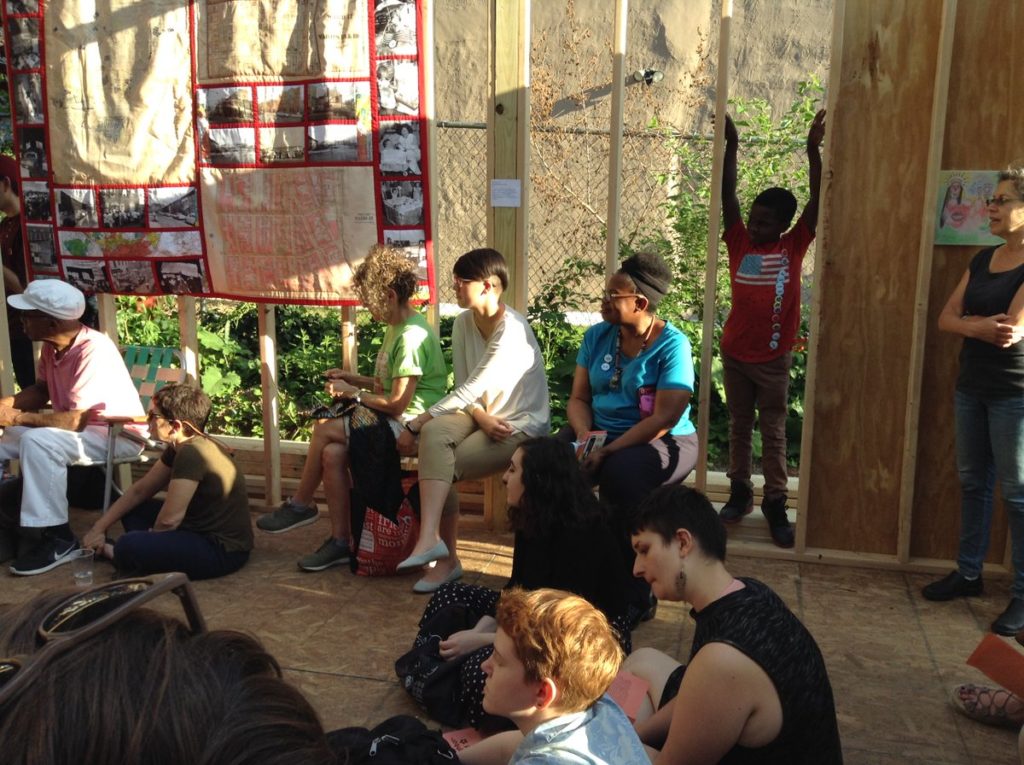Philadelphia Assembled asks: What does a ‘just neighborhood’ look like?
 June 5, 2017
Category: Event, Feature, Featured, Long, Results
June 5, 2017
Category: Event, Feature, Featured, Long, Results
How can community, conversation and collaboration work together to create a “just neighborhood”? What was Kensington like before gentrification, and how has it changed?
These questions were brought up during the house-raising ceremony and celebration of the “Blueprint for a Just Neighborhood” site at the Tillmon Community Garden last week. It’s one of two projects coming out of the “Reconstructions” working group of the citywide Philadelphia Assembled initiative from the Philadelphia Museum of Art.
This specific site, which is a barebones visual representation of what an affordable home would look like in the neighborhood, is looking at gentrification and displacement through the “lens of reconstructions,” said Phoebe Bachman, a project coordinator and collaborator — especially during a time when more and more luxury home developments have sprung up in this part of Philly.
"What would it look like if we created a space ... not just for luxury but for anyone?"
“It’s always a question of who are the houses for,” Bachman said. “So we wanted to ask, ‘What would it look like if we created a space, room where you could see how this housing is brought up, not for luxury but for anyone?’”
Collaborating with and taking inspiration from organization such as the Women’s Community Revitalization Project and the Philadelphia Coalition for Affordable Communities, the “Reconstructions” working group also brought together artists and storytellers to produce their own interpretations of the project’s themes.
Tieshka Smith, whose documentary storytelling and photography examines changes in places like Germantown and Brewerytown, produced a street photography series capturing candid moments throughout South Kensington and will soon start a podcast series where she’ll be interviewing community members about what their idea of a “just neighborhood” is.
Even though Smith is a Chicago native, she said her time spent in other urban places like Philly has shown her the national trend of cities moving toward displacement strategies instead of working with community members to make better living neighborhood conditions for everyone.
“From a national perspective, gentrification and displacement are economic strategies that give cities the opportunity to raise cash,” Smith said.
Each of the artists and storytellers brought on by organizer Denise Valentine to produce something for the site — Smith, Lisa Adjei, Betty Leacraft, Mona Washington, Brujo de la Mancha and Staci Moore — all incorporated, and encourage, some level of community engagement in their works. For instance:
- Adjei produced a watercolor painting that came out of talking with neighborhood residents of their histories as well as what they think about the area today, in an effort to “reconcile the past with the present in trying to build a better future,” she said.
- Leacraft, known for her work in quilting, created her biggest work yet which now hangs on one of the walls of the site. It contains historic photographs and pictures of the neighborhood she obtained from the archives of the special collections research center at Temple University’s Paley Library, as well as maps.
- Washington wrote, directed and featured in a three-person play that took place inside the site, which touched on the differing values and sentiments older and newer “hipster” residents had about Philly’s neighborhoods.
For Anthony Kamani and Asaki Kuruma, who starred in the play with Washington, a chance to make any sort if statement is a good one.
“It’s a small ripple but it’s a ripple you can make to make a change in the city,” Kuruma said.
It’s these sorts of gatherings, forums and conversations that Jeanne van Heeswijk, the mind behind the whole Philadelphia Assembled project, hopes will continue even after all the different components of the project are completed and eventually placed in the PMA.
As someone who talked with more than 300 people in the span of three and a half years to prepare this ambitious project, she is also adamant about taking the focus away from her and onto the many diverse collaborators involved with the project.
“We’re not so good at that, at allowing many different voices,” Heeswijk said. “I may have initiated the project but these are all the people leading it.”
Project
Philadelphia AssembledTrending News










